Just like clunky eight track cartridges, brick sized cellphones and desk hogging CRT monitors, the trusty hard disk could be heading for oblivion as Intel announce their first move into the flash drive market.
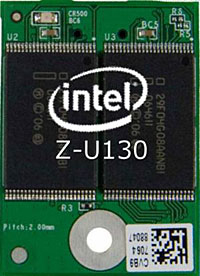 Yesterday, the electronics big boy elbowed its way onto the Flash Memory table clutching news of their Intel Z-U130 Value Solid-State Drive, offering USB 2.0/1.1 interfaces.
Yesterday, the electronics big boy elbowed its way onto the Flash Memory table clutching news of their Intel Z-U130 Value Solid-State Drive, offering USB 2.0/1.1 interfaces.
Despite its instantly forgettable name, Intel reckons that the NAND flash memory can whip the spinning botty of hard disk drives and removable USB storage devices, offering nippier boot times, embedded code storage, faster data access, silent operation and lower power consumption.
Although no one’s predicting that flash memory will replace hard disks quite yet (mechanical drives still enjoy a considerable cost advantage at large capacities), Greg Matson, product marketing manager for Intel’s NAND flash memory division reckons they could provide a more reliable and cheaper way of storing information on PCs for emerging markets.
The drives could also be fitted into PCs and servers as a way to speed up the boot process, and thus deprive workers of a good excuse to pop out for a walk, “while the PC’s starting up.”
Intel is currently keeping schtum about the pricing for their Z-U130 Value Solid-State Drives (it doesn’t get any more memorable the second time around, does it?) but the capacities will vary from 1GB to 8GB, with 8GB drive not expected to emerge until the end of the year.
Intel’s Green Xeon Processors
Elsewhere, Intel were giving their Eco-Trumpets an extra long parp with the announcement of two new Quad-Core Xeon processors – the L5320 and L5310.
Intel claims that these offer between a 35 and 60 percent reduction in power consumption on low-power, quad-core processors designed for high end users like data centres, blade servers and financial industries.
“Intel has really responded to the industry’s call to deliver unprecedented breakthroughs for datacenter energy efficiency,” frothed Kirk Skaugen, VP of Intel Digital Enterprise Group and GM of the Server Platform Group.
“IT managers can get outstanding quad-core Intel Xeon server performance today and at no premium to dual-core products,” he added.

 Sony is gearing up to launch a rival to popular online virtual world
Sony is gearing up to launch a rival to popular online virtual world 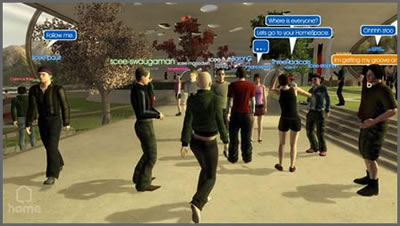

 BT is under a legal obligation to provide phone boxes up and down the length of the UK, which they claim numbers 63,795. BT say that 40,500 of these phone boxes are unprofitable.
BT is under a legal obligation to provide phone boxes up and down the length of the UK, which they claim numbers 63,795. BT say that 40,500 of these phone boxes are unprofitable. Last week Microsoft went on a PR offensive to promote the new format, despite them having
Last week Microsoft went on a PR offensive to promote the new format, despite them having  In the interview with German weekly magazine Focus, published today, she poses the following question, “”Do you think it’s fine that a CD plays in all CD players but that an iTunes song only plays in an iPod?” It’s followed by a couple of words that are going to make uncomfortable reading for Apple, “I don’t. Something has to change.”
In the interview with German weekly magazine Focus, published today, she poses the following question, “”Do you think it’s fine that a CD plays in all CD players but that an iTunes song only plays in an iPod?” It’s followed by a couple of words that are going to make uncomfortable reading for Apple, “I don’t. Something has to change.” Three Quarters Of Consumers Naffed Off With Mobile Web
Three Quarters Of Consumers Naffed Off With Mobile Web Mercer joined Apple in 1987 and was the lead designer of Version 7 of the Macintosh finder before founding a software tools firm called Pixo which was involved in designing the first version of the iPod user interface.
Mercer joined Apple in 1987 and was the lead designer of Version 7 of the Macintosh finder before founding a software tools firm called Pixo which was involved in designing the first version of the iPod user interface.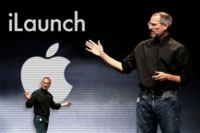 Voice-recognition software, Apple’s most advanced to date, can recite a speech highlighting the features of the device while injecting several clever digs at competitors.
Voice-recognition software, Apple’s most advanced to date, can recite a speech highlighting the features of the device while injecting several clever digs at competitors. A pretty staggering number, even when you realise that it includes all of the downloads and possibly all upgrades of the software (* We’re in the process of checking this with Skype HQ).
A pretty staggering number, even when you realise that it includes all of the downloads and possibly all upgrades of the software (* We’re in the process of checking this with Skype HQ). In the wake of US newspaper
In the wake of US newspaper  The recently relaunched
The recently relaunched 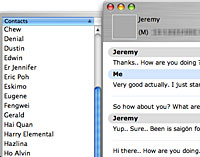 The Palm platform has traditionally enjoyed a lot of support from Mac users who can perhaps relate to the platform’s status as a great working product that isn’t as well known as it should be (or maybe it’s because it’s simply not Windows?!).
The Palm platform has traditionally enjoyed a lot of support from Mac users who can perhaps relate to the platform’s status as a great working product that isn’t as well known as it should be (or maybe it’s because it’s simply not Windows?!). All the messages are searchable and the program offers international language support.
All the messages are searchable and the program offers international language support.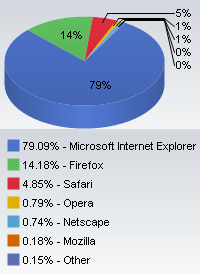 Like hungry puppies with sharp teeth, Mozilla’s Firefox and Apple’s Safari Web browsers continue to chew and gnaw away at the juicy legs of Microsoft’s Internet Explorer (IE).
Like hungry puppies with sharp teeth, Mozilla’s Firefox and Apple’s Safari Web browsers continue to chew and gnaw away at the juicy legs of Microsoft’s Internet Explorer (IE). “After a minor hiccup in January, Firefox seems to be back on the offensive in February,” said the fabulously named Vincent Vizzaccaro, Net Applications’ executive vice president of marketing and strategic relationships.
“After a minor hiccup in January, Firefox seems to be back on the offensive in February,” said the fabulously named Vincent Vizzaccaro, Net Applications’ executive vice president of marketing and strategic relationships.